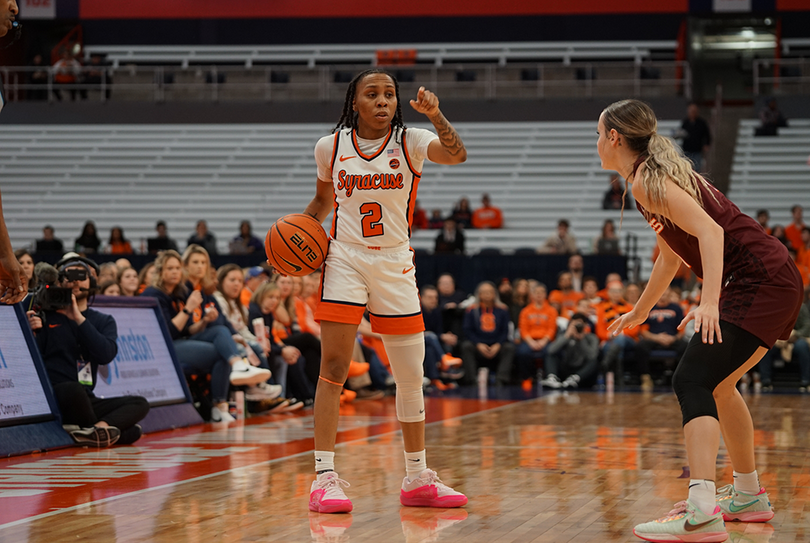Against Virginia Tech, Syracuse failed to replicate a 4th-quarter comeback

Courtesy of Griffin Uribe Brown | TheNewsHouse.com
Syracuse failed to come up with fourth-quarter magic against Virginia Tech, en route to a 13-point loss.
Get the latest Syracuse news delivered right to your inbox. Subscribe to our sports newsletter here.
Syracuse entered the fourth quarter of Sunday’s matchup against Virginia Tech trailing 55-47. It was a position the Orange had been in before. They’d dug themselves deep holes all season long, but constantly pulled themselves out. So why would anyone expect a different result?
SU’s confidence was high after outscoring then-No. 15 Notre Dame 28-14 in the fourth quarter just three days before — as the Orange completed a season-sweep over the Fighting Irish for the first time in program history. In the past three weeks, strong fourth quarters propelled Syracuse to multiple comeback victories, yet this time, it couldn’t claw its way back.
No. 21 Syracuse’s (17-3, 7-2 Atlantic Coast Conference) fourth-quarter magic ran out against No. 17 Virginia Tech (16-4, 7-2 ACC) in a 75-62 defeat. The Orange weren’t outclassed in the fourth quarter — outscored by just five points — but their failure to execute down the stretch was uncharacteristic. Unlike previous games, Dyaisha Fair couldn’t take over, Syracuse struggled on the offensive glass and its six-game winning streak screeched to a halt.
“We got to get better within ourselves,” said SU head coach Felisha Legette-Jack postgame.

Syracuse shot 5-for-20 in the fourth quarter during its loss to Virginia Tech on Jan. 28. Courtesy of Griffin Uribe Brown | TheNewsHouse.com
Entering Sunday, through seven ACC victories, Syracuse outscored its opponents 168-116 in the fourth quarter. The Orange have displayed an uncanny ability to come back from large deficits.
In back-to-back wins against Clemson and then-No. 15 Florida State, SU trailed by 19 and 18 points, respectively. A 30-point fourth quarter against Clemson sparked a comeback, capped off by Alyssa Latham’s game-winning layup with seven seconds remaining. Against FSU, Fair exploded for a program-record nine 3-pointers and season-high 31 points.
Then, the Orange displayed lockdown fourth-quarter defense to help down Notre Dame. ND went the first five-and-a-half minutes without a bucket, and was held to just five makes from three total.
“We just had to keep (Notre Dame) on their heels defensively,” Legette-Jack said after the win.
A similar theme developed throughout those fourth quarters: SU played at its pace. When it wanted to speed teams up, it did. Whether it was Georgia Woolley’s on-ball pressure or Kyra Wood roaming the paint and cutting off driving lanes, Syracuse’s offense fed off its defense. The Orange quickly created chaos and hit teams before they even realized what happened.
“We’re going to fight to the finish whether it goes our way or not. But we have to feel and know that we left it all out there no matter what the score says at the end of the game,” Fair said on Jan. 18. “So I think if we just wait until the last four sounds, see where it gets us.”
Against Virginia Tech, though, the Hokies remained composed due to the play of point guard Georgia Amoore. With reigning two-time ACC Player of the Year Elizabeth Kitley registering her worst shooting performance of the season — 3-for-13 with six points — Amoore took the reins of the offense. The point guard scored 29 points on 10-for-17 shooting, just two points shy of her career-high which came against Iowa on Nov. 9, 2023.
Typically known as a distributor with an ACC-leading 7.3 assists per game, Amoore’s offense was too much for the Orange. She easily got to her spots and answered whenever Syracuse threatened to make a run.
“She just played her game and I mean that’s what she does and we gotta step up regardless,” said SU guard Alaina Rice.

Miranda Fournier | Design Editor
Amoore outplayed Fair, who finished with just 16 points on 6-for-15 shooting. Six of Fair’s points came in the fourth quarter, but she couldn’t will her team to a comeback. A double-clutch floater through contact with seven minutes left cut VT’s lead down to 59-54.
On the other end, Fair switched onto Amoore after an Olivia Summiel screen. Summiel set another pick as Amoore split Wooley and Fair, who failed to cut her off. Wood came to help, but Cayla King was left wide open from the wing, knocking down a 3-pointer with Rice too slow on the closeout.
A Wood and-one cut the lead back down to five, but Syracuse went the next three minutes without a field goal.
Virginia Tech had back-to-back empty possessions, yet Syracuse couldn’t take advantage. First, Fair took a contested mid-range jumper which fell short. Then Rice came dashing up the floor and had a layup attempt blocked by Clara Strak. Latham corralled the board, but she was out of bounds.
In previous games, Syracuse made the plays to get over the hump. It failed to do so against Virginia Tech.
Woolley faceguarded Amoore on the other end, but she shielded her off with her body as she passed halfcourt. Amoore then found King again for 3 to put VT up 65-57 with three minutes left.
A Fair 3-pointer one minute later made it 67-60. Then, Amoore stuck in the dagger. Using a Kitley screen, Amoore split between Wood and Woolley before rising up on one leg to drain a floater in the paint, putting the Hokies back up nine.
The final quarter came down to efficiency. Despite Syracuse taking 20 shots in the fourth — six more than Virginia Tech — it only made five. The Hokies had six on more than 40% shooting. Down the stretch, VT’s offense executed better and received more high-percentage looks than SU’s.
Fair gave one last 3-point heave, but it fell short and so did Syracuse’s hopes of completing another massive comeback.





